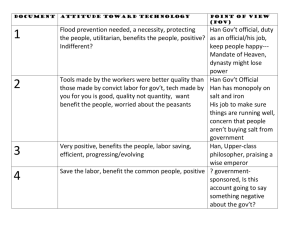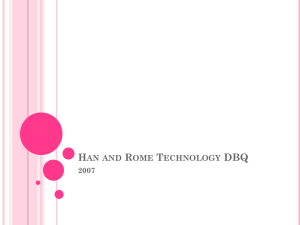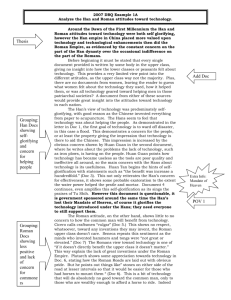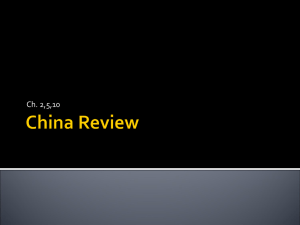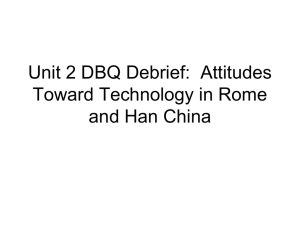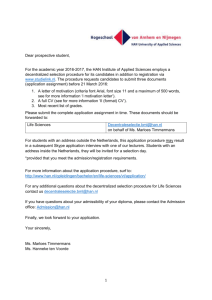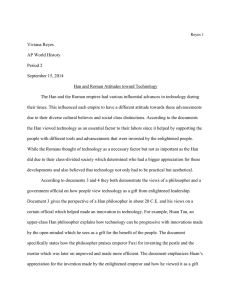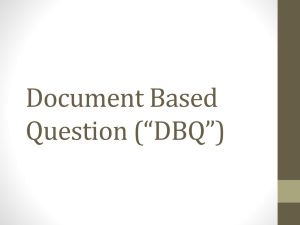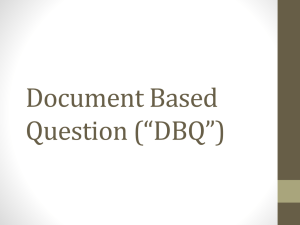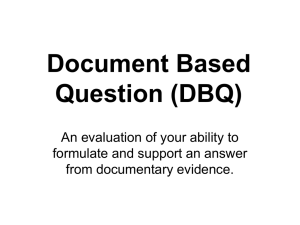Doc Ref Sentence
advertisement
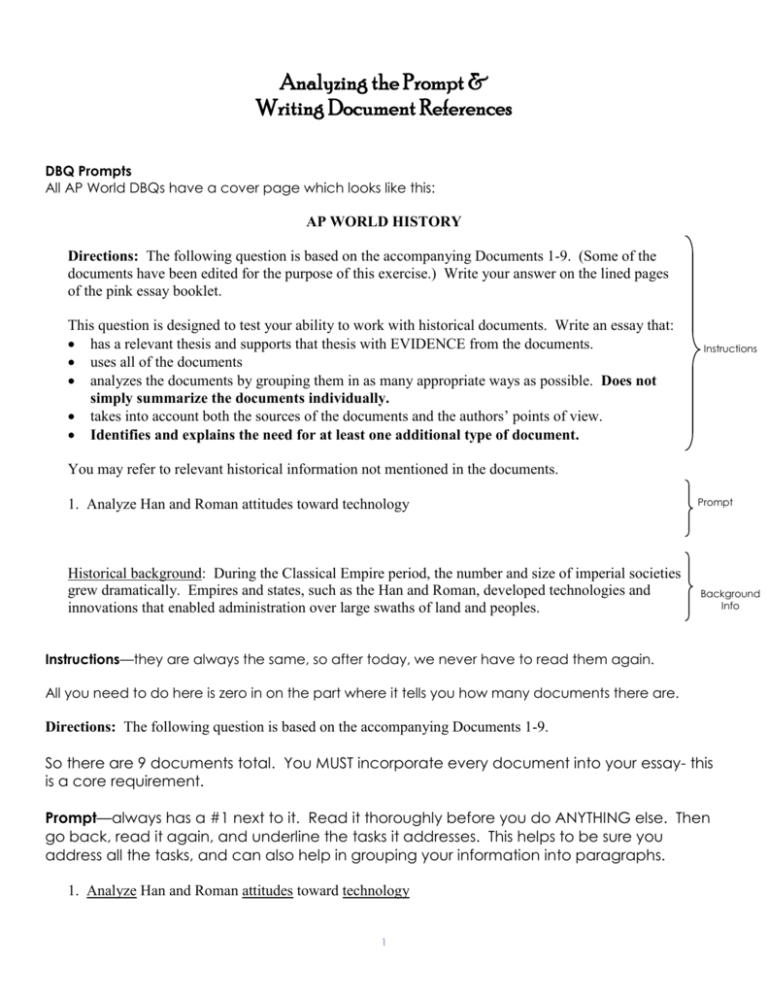
Analyzing the Prompt & Writing Document References DBQ Prompts All AP World DBQs have a cover page which looks like this: AP WORLD HISTORY Directions: The following question is based on the accompanying Documents 1-9. (Some of the documents have been edited for the purpose of this exercise.) Write your answer on the lined pages of the pink essay booklet. This question is designed to test your ability to work with historical documents. Write an essay that: has a relevant thesis and supports that thesis with EVIDENCE from the documents. uses all of the documents analyzes the documents by grouping them in as many appropriate ways as possible. Does not simply summarize the documents individually. takes into account both the sources of the documents and the authors’ points of view. Identifies and explains the need for at least one additional type of document. Instructions You may refer to relevant historical information not mentioned in the documents. 1. Analyze Han and Roman attitudes toward technology Prompt Historical background: During the Classical Empire period, the number and size of imperial societies grew dramatically. Empires and states, such as the Han and Roman, developed technologies and innovations that enabled administration over large swaths of land and peoples. Background Info Instructions—they are always the same, so after today, we never have to read them again. All you need to do here is zero in on the part where it tells you how many documents there are. Directions: The following question is based on the accompanying Documents 1-9. So there are 9 documents total. You MUST incorporate every document into your essay- this is a core requirement. Prompt—always has a #1 next to it. Read it thoroughly before you do ANYTHING else. Then go back, read it again, and underline the tasks it addresses. This helps to be sure you address all the tasks, and can also help in grouping your information into paragraphs. 1. Analyze Han and Roman attitudes toward technology 1 This prompt has given us two tasks: analyze Han attitudes toward technology analyze Roman attitudes toward technology Here are some common task words that appear in AP essay prompts. Define each one. Analyze— Compare— Contrast— Discuss— Evaluate— Background Info—very useful because often, DBQ prompts often address obscure events that no one has ever heard of (OK, maybe not no one, but they often use topics that are unfamiliar to most tenth graders). DO NOT PANIC. The purpose of a DBQ is to measure how well you can read and evaluate documents. Read the background info and your documents and you can write a great essay even with no prior knowledge of the topic. Reading Documents and Prewriting—each DBQ has between 9-14 short excerpts of documents. Usually they are primary source documents, but occasionally there are secondary sources as well. Most will be written documents, but often there are visual documents thrown in, such as maps, paintings, and charts. Your first goal is to read each document quickly, get the gist of it, and jot down the main idea somewhere in the margin. Historical people often spoke very formally and used archaic language. Don’t worry if you don’t understand every word of every document. Just jot down the main idea and move on. Writing Document References—references to documents are going to provide the bulk of your evidence that proves your thesis in a DBQ. Basically you are just going to write sentences that summarize or paraphrase how the documents reflect on the prompt. Three things to remember about document references: NEVER, EVER, EVER DIRECTLY QUOTE A DOCUMENT. ALWAYS PARAPHRASE— SUMMARIZE WHAT IS STATED IN THE DOCUMENT IN YOUR OWN WORDS. SINCE YOU ARE NOT DIRECTLY QUOTING, DO NOT USE QUOTATION MARKS. “DOUBLE ATTRIBUTE” EACH DOCUMENT REFERENCE SENTENCE. REFERENCE THE SOURCE BY NAME WITHIN THE SENTENCE, THEN END THE SENTENCE WITH A PARENTHETICAL CITATION OF THE SOURCE LETTER OR #. 2 Example of a perfect document reference sentence: Document A Source: Han government official, writing to local officials concerning flood prevention, early second century B.C.E. I request that you establish water conservation offices in each district and staff them with people who are experienced in the ways of water. There should be one high official and one deputy with just enough workers to meet the need. For the area on both sides of each river select one person as chief hydraulic engineer. Order inspections of the waterways, the walls of the cities and their suburbs, the dikes and rivers, canals and pools, and government buildings and cottages, and supply enough workers to those who are to carry out the repair work in each district. Remember: tasks are to analyze Han and Roman attitudes toward technology Main idea: attitude- Han government officials used and regulated technology relating to water Perfect document reference sentence: A Han government officer directed local officials to establish water conservation offices filled with experienced workers to monitor and repair canals and pools, which demonstrated the government’s embrace of flood prevention technology to ward off a disaster.(Doc. A) Practice Part I: Evaluating Document References - Determine whether each of the following document references fulfills all of the requirements. If not, rewrite the document reference to make it correct. Document B Source: Huan Guan, Han government official, Discourses on Salt and Iron, first century B.C.E. In earlier times workers were allowed to do both foundry work and salt-boiling as long as they reported the work and paid a tax. Tools manufactured by individual families to do this work were well-made. Today the iron tools that workers are required to use are produced by the state using convict labor; these tools are often crude and not very functional. In previous times the tools manufactured by workers for their own use and for sale were of excellent quality. Now that the state has monopolized the salt and iron trades, most of the tools provided to the workers are hard and brittle and the responsible government officials are often not available to take complaints. Good implements are hard to come by. Salt and iron are now sold at very high prices by the state and many common people cannot afford to buy either. Some of the poorest peasants now have no choice but to till the soil with wooden plows and cannot afford salt to season their food. 1. Document Reference sentence: According to Huan Guan, a Han government official in the 1st century BCE, “Tools manufactured by individual families to do this work were well made. Today the iron tools that workers are required to use are produced by the state using convict labor; these tools are often crude and not very functional.” (Doc B) Is this a valid document reference? yes no 3 If no, why? _____________________________________________________________________________ If no, rewrite the reference correctly. _____________________________________________________ __________________________________________________________________________________________ __________________________________________________________________________________________ Document C Source: Huan Tan, upper-class Han philosopher, New Discourses, about 20 C.E. Fuxi* invented the pestle and the mortar. Later on, the pestle and the mortar were cleverly improved in such a way that the whole weight of the body could be used, thus increasing the efficiency ten times. In time, the power of animals— donkeys, mules, oxen and horses—was added. Later, water power was also applied, and the benefit was increased a hundredfold. *Fuxi is a mythological wise emperor. 2. Document Reference sentence: According to Huan Tan, in his book “New Discourses,” the Han have adapted and improved technology such as the pestle and mortar to increase work efficiency, showing a full embrace of equipment that benefits society (Doc C). Is this a valid document reference? yes no If no, why? _____________________________________________________________________________ If no, rewrite the reference correctly. _____________________________________________________ __________________________________________________________________________________________ Document D Source: History of the Early Han Dynasty (government-sponsored history), about 200 C.E. Te Shih was appointed governor of Nanyang [about 31 C.E.]. He was a generous man and his policies were peaceful. He destroyed evil-doers and established the dignity of his office. Good at planning, Te Shih loved the common people and wished to save their labor. He invented a water-powered blowing-engine for the casting of iron agricultural implements that allowed people to enjoy great benefit for little labor. His invention has been widely adopted and used 3. Document Reference sentence: An emperor created a water-powered blowing engine. (Doc D) Is this a valid document reference? yes no If no, why? _____________________________________________________________________________ If no, rewrite the reference correctly. _____________________________________________________ 4 __________________________________________________________________________________________ Document E Source: Cicero, upper-class Roman political leader, On Duty, first century B.C.E. Now, as to which crafts and other means of earning a living are suitable for a gentleman to practice and which are degrading, we have been taught more or less the following: Vulgar and unbecoming to a gentleman are all the jobs hired workers take on, whose labor is purchased rather than their skill. All craftsmen spend their time in vulgar occupations; no workshop can have anything enlightening about it. 4. Document Reference sentence: According to Cicero in the 1st century B.C.E, gentleman ought not to take part in a craft or a workshop because it was vulgar, showing that upper class Romans saw no need or use for technology (Doc E). Is this a valid document reference? yes no If no, why? _____________________________________________________________________________ If no, rewrite the reference correctly. _____________________________________________________ __________________________________________________________________________________________ Practice Part II: Writing Your Own Document References Document F Source: Plutarch, Greek-born Roman citizen and high official, describing second-century B.C.E. Roman political leader Gaius Gracchus, first century C.E. He was especially anxious about road building, paying attention to utility as well as to that which was beneficial to grace and beauty. For the roads were carried straight through the country without wavering, and were paved with quarried stone, and made solid with masses of tightly packed sand. Hollows were filled up and bridges were built across whatever wintry streams or ravines cut the roads. And both sides were an equal and parallel height with the result that the road for its entire course had a level and beautiful appearance. Besides these things, he measured the whole road mile by mile and set up stone columns as distance indicators. He also placed other stones on either side of the road at lesser intervals so that it would be easier for those who had horses to mount them from the stones without requiring a groom to help. 5. Main idea—responses and/or beliefs: __________________________________________________ _________________________________________________________________________________________ 6. Document reference sentence: _______________________________________________________ __________________________________________________________________________________________ _____________________________________________________________________________ ( 5 ) Document G Source: Seneca, upper-class Roman philosopher and adviser to Emperor Nero, first century C.E. I do not believe that tools for the crafts were invented by wise men. The question of whether the hammer or the tongs came first does not seem important to me. Both were invented by someone with a mind that was nimble and sharp, but not great or elevated. 7. Main idea—responses and/or beliefs: __________________________________________________ _________________________________________________________________________________________ 8. Document reference sentence: _______________________________________________________ __________________________________________________________________________________________ _____________________________________________________________________________ ( ) Document H Source: Frontinus, Roman general, governor of Britain, and water commissioner for the city of Rome, first century C.E. All the aqueducts reach the city at different elevations. Six of these streams flow into covered containers, where they lose their sediment. Their volume is measured by means of calibrated scales. The abundance of water is sufficient not only for public and private uses and applications but truly even for pleasure. The water is distributed to various regions inside and outside the city, to basins, fountains and public buildings, and to multiple public uses. Compare such numerous and indispensable structures carrying so much water 9. Main idea—responses and/or beliefs: __________________________________________________ _________________________________________________________________________________________ 10. Document reference sentence: __________________________________________________________________________________________ __________________________________________________________________________________________ ______________________________________________________________________ ( 6 )
